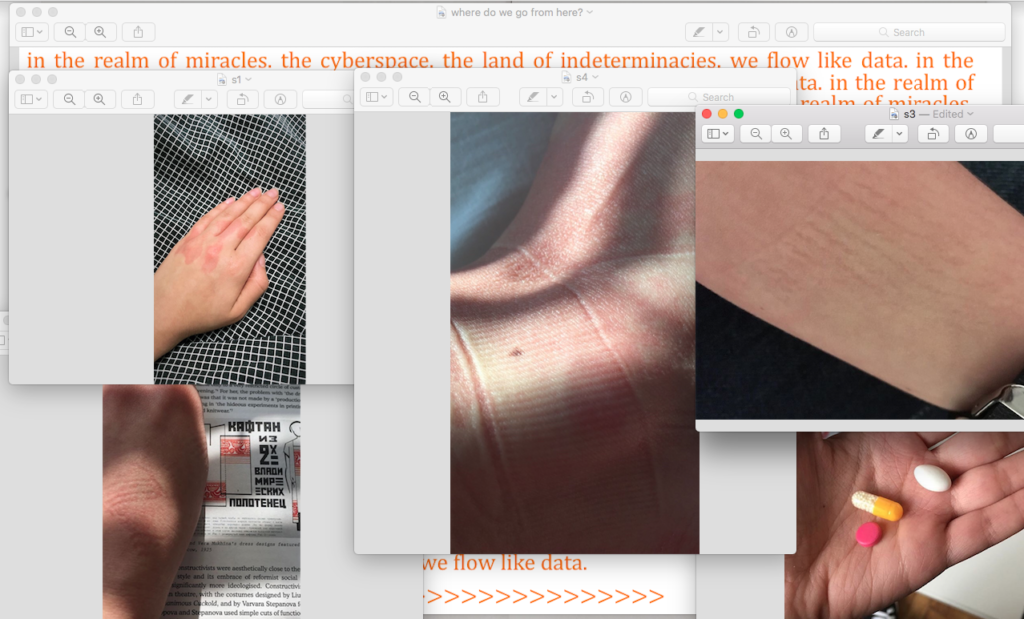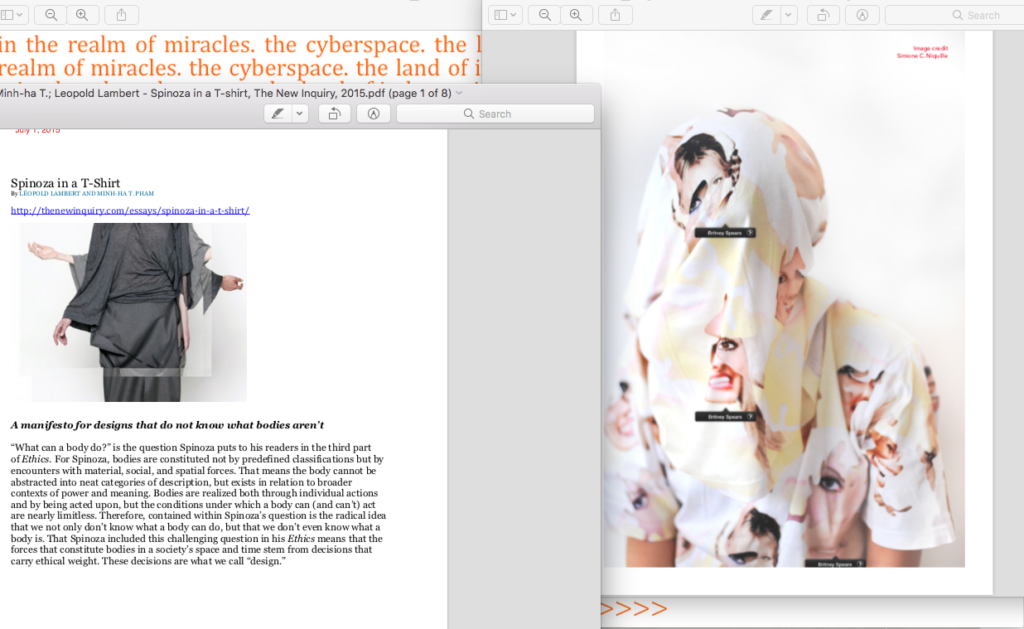Corruption of forms. Or fashion like a digital cloth – one ill-fitting draft

If I am to say fashion and the digital, the first thing that comes to mind would probably be the changes that brought the so-called democratization of fashion through online platforms and image sharing, especially the social media impact. ‘Instagram it!’ – you know how that goes. Or, on the other side of the spectrum, the relationship between the two, every so often surfaces in ‘scandals’ over digitally retouched images of celebrities and models – those idealized bodies that here and there lost touch with an anatomical bone structure. What if instead of the digital perfected body or the ‘materialized ideal body of the models’ – as Franziska Bork-Petersen called it1 – we were to shift the discussion towards touch? Can we treat fashion as an ‘in-process-of-becoming’ digital skin? Here I am, attempting to draft a thought that I picked up somewhere else and since let the hive-mind unfold.
“Soon there will be digital skins that are tattooed to the biological skin and become sensing systems of our bodies” – wrote Yvonne Förster, pointing that fashion and wearables are forerunners of integrating technology into our bodies and everyday environments. In this pressed contact on the body, they can upsurge other sensibilities.2
Digital skins, as Förster envisions them, stand in for wearables, projections, smart fabrics, and flexible electronics, among others, that, attaching to the body, can extend it. In close proximity to the user’s body, they tend to “merge artificial and biological life,” altering “the social and material structures of our life-worlds. (…) It covers both technologies becoming life, and humans incorporating artificial devices.” A two-folded process like this addresses, simultaneously, our relationship and sensory forms of relating the body to the world, as well as the development of devices seen as smooth as possible, almost organically integrated into everyday life. Sensitive, smart, and connective, part of the life-world, where ‘ideally a digital skin becomes immaterial, washable, expandable, like the skin itself.’ 3
Beyond being just a site of modifications, what comes forward is the sensorial body for which the skin is the mediator between outside and inside, and in contact with the (wired) materials covering them. Fashion – should be underlined – has a long history of easing technology in and for the body, and through it changing our perceptiveness. In this sense, we need to asses not only a fashioned but also a techno-body. Textiles – as Virginia Postrel recalls in ‘Losing the Thread’–, have radicalized the way we understand clothing, yet, making it so natural that we take it for granted. Fabrics and fibbers have merged economy, innovation, and body extensions since their inception. Always moving forward, they conduce chemical production and microfibers, among others, as soft surfaces, but also as resisting materials that can make clothes long-lasting. This ‘cultural amnesia’ of the synthetic – which we rarely pronounce nowadays – happens mainly because continuous innovation tends to become blasé at one point. On the same note, digital printing has become a practice that, even low-scaled, has managed to impact the visual effect of clothes and the open-source patterns. 4 Part of the everyday, we’re aware of the innovations in our clothing only in the glimpse of a ‘hi-tech’ tag attached to our usual parkas, or thermo-undergarments, conveying a scientific ring to them.
Garments, one could say, own a lot of their fascination to direct contact with the skin in which they create both touch and reaction. It is here, in the interstice between cloth and skin, where the politics of the body have always found their main battleground. It’s not my intention to reiterate the violent history of instrumenting the body to a fault, molding and disciplining it through dress and fashion – though it is a reminder taken into consideration, an underlay. Sexuality, gender, race, remain issues more relevant than ever. Yet, one also has to flip the coin for the odd. The influence such skins might have can help us rethink this interstice between body and clothing in the aftermath of those ‘idealized’ images shared around.
Design has played a crucial part in constructing a specific idea of the body in relationship with the environment, like a device that can be tuned in, adjusted, in order to become something of a frictionless machine. This image of the 20th century keeps creeping in5, not only in the wellness discourse that addresses our bodies today but also in our smooth surface technological devices and crisp images. Everything can slide on them, orgasmic. The body becomes information, data that is translated into form, and with it, the body designed anew. Neoliberal strategies have taken particular such aspects under their dominion, where the physical is information, shared, stoked, made risk free, and implemented as future performative potential.
There’s a project I keep returning to from time to time, one that I always misplace, re-place, and excavate later in the ‘pool of data’ that has become my hardrive: Skinthetic. A speculative proposal of studio KnoWear that instead of fashion items it presents the body’s reactions to brands translated as saturation on the skin. Fashion transforms quite literary into a rush, a morphing, flexible softcover, where logos come up like protuberances. What got my attention is not only the critique of the chemical production of textiles and fashion images,6 but moreover the sensuousness of the skin, its organic growth, and potential for transformation, for feeling differently. The way fashion rushes on the surface of the skin gives a sense of a moving, living body, but also how such changes might affect our own understanding of how a body moves, acts, senses. Fashion here becomes both the potential of transgressing into ‘a branded object of desire’ and the disturbance that sets the body back into a felt sensation.
If we are to think first about incorporated devices which can make our skin a canvas for light projection and mapping, or just other sensibilities, the way information is gathered and reproduced can be an equally sensible issue to tackle. The question is, how are we to reconsider such a digital envelopment given the algorithmic patterns and 3D models still in debt to a ‘configuring’ that seems to know all too well what a body is? It is indeed the thorny issue of thinking differently this representation that arranges the body and sets it under the light as a contact sheet where all the cultural debris gets swapped in. Can the form be corrupted? Can the algorithm be made to dance according to another rhythm? Where would a digital skin un-become the body it wears?
In a manifesto for ‘queering design,’ theorist Ece Canli proposes ‘queer’ as a verb for active involvement, an in-becoming process that continually revisits itself. This would mean a way to introduce disruptions in everyday processes and strategies for making weird the normative.7 Given the new technologies and wearable designs that connect across the body, this critical aspect needs to be incorporated into digital fashion skins. First, because the (western) cultural stereotypes often ask of women to reveal more of their skin,8 as well as queer people to perform themselves, to be exposed. Thus, how new wearables are to function is equally a question of queering design, of acknowledging that we are still to deal with the prejudices organizing design and technology accounting for the candid voices our innovative devices are endowed with.
To paraphrase Patrick Jones: technology is infrastructure. We build screens, and they build us back – “and as technology probes deeper into life’s mysteries, splicing into question of being, the right of a creator to implicate human experience and ontology is vague.” The way you are tagged, and if you can be forgotten, then it is always a matter of what the machine is fed with.9
In this sense, the protocols that mediate such encounters between our bodies and the digital must undergo a process of rethinking similar to clothing disturbances attempting to ignore predetermined ideas of what a body is and can do. Revisiting how we can do away with the normativity landing on the body one way or another, Lèopold Lambert and Minh-Ha T. Pham ask as well for a different approach, one that echoes the ‘queering’ process just otherwise. Turning to Spinoza’s outline of a body always constructed through its encounters (from space and other bodies – human or not), in the sense that we don’t really know what a body is and can do, the authors propose a slight modification, however. Their version addresses the holistic implication the philosopher suggestion might involve, namely, that there is a knowable body which we are to discover. Instead, they propose a double negation: ‘If we don’t know what a body isn’t, then everything is a body’ – which leaves the idea of the body indefinitely open, rather than just momentarily. The bodies we carry ourselves and the ones with which we interact with are reciprocally constructed through these interactions. “To not know what a body isn’t, means that all bodies are equally valid modes and forms of embodiment. Nothing is “not a body,” and so everything is a body.” 10 What if, in this connection, the bodies themselves become the tool of disturbance changing the predetermined features of a design, and as such, feed another data and instrument technology differently?
‘Our bodies of the post-disciplinary, control society are the expression of automatism and habits from the previously disciplinary and older power regimes. Old and new commands are embodied and expressed in our free movements and behaviors’
– Florin Flueraș, “Second Body,” in Unsorcery, 2018
In this context, looking at how another body might emerge – Alina Popa notes that “all organisms create experimental rules to simplify their world.” This makes speculating on how the body as an already techno-world11 can escape its form and trans/re/pre/un – form, one of those necessary tasks in understanding not only the tech- but also the inside or a living organism moving beyond extinction. If some ‘unlimited’ might occur in-between the liquidity of the screens and the surface of the skin, the emerging sensibility will probably take an intuitive path. Unspoken and shifting in representations.
Play that tune again: [ if we don’t know what a body isn’t, then everything is a body]
In ‘The Search Drive: A Hackography Begins’, artists Bik Van der Pol note: “We are witnessing a shift from a form of data searching and surveillance in which real fingers and thumbs of real hands connected to real bodies revealing themselves by making tapping sounds on keyboards, are substituted by a disembodied algorithmically generated system of total silence.” Referring to bots interference in our structures of thinking and acting, one could also add that they could create mediation in a manner that remains non-linear and somewhat obscure.12 While this might send us back to the protocols of information, awareness towards the process might create other gaps in responding and reacting, of giving body and receiving touch, there where control is lost.
Skin, body’ surface, is: “open, processual, relational and sentient; it is human and non-human, material and immaterial, indeterminate and multiple; and finally, it is crucially bound with thinking and indeed, rethinking agency, power and technology,” as Marc Lafrance summarizes.13 The transitional quality skin holds, and this ‘taking-flesh’ it suggests, makes the recurrence of the digital on its surface such a valuable site – where the human and the non-human meet and sleep together. Entangled. Interlinked. Maybe this is the point where we are now, in which fashion emerges as a rush on the surface. It’s pointing to the digital milieu of luscious bodies and objects caught in-between the New Aesthetics of screens and constant connectedness similar to the Internet of Things. All wiring in the brain and at the swish of a fingertip. Just that this particular rush is not of a branded reference, but that of an ever-morphing skin of bio-technological assimilation.
Edith Lázár is a fashion theorist in the making and occasional art writer. Her research and wonderings focus on aesthetic politics, fictions as alternative structures of perception and forms of visibility, as well as the imbrications between art, fashion, practice, and the everyday. As an associate editor of the Fashion Series for contemporary art platform anti-utopias, she explored these aspects through book reviews and interviews. Taking an interest in artistic practices, she was a former collaborator of SPRLQDT Art Space and is the co-founder of and part of the curatorial collective Aici Acolo, reactivating unused or abandoned urban spaces in Cluj-Napoca by transforming them into temporary art space showcasing young artists.
Franziska Bork-Petersen – Idea, Imagined, Impossible: Fashion’s Utopian Bodies, in Utopian Bodies. Fashion Looking Forward, Liljevalche, 2015, p. 21-22
Yvonne Förster – From Digital Skins to Digital Flesh: Understanding technology through fashion, in Popular Inquiry. The Journal of Kitsch, Camp, and Mass Culture, Vol.1, 2018, p. 33
Ibid. p.33-34
Virginia Postrel, Losing the Thread, Aeon Mag, 2016
Beatriz Colomina and Mark Wigley – are we human? notes on an archelogy of design, Lars Müller Publishers, 2016, p.152
Skinthetic Redux is a photographic series by KnoWear [Peter Allen+Carla Ross Allen], commissioned for the UK art book, Made In Code, 2011 – which I found on the vast sea of the Internet a couple of years ago.
Ece Canli, Queering Design: A Theoretical View on Design vs. Gender Performativity. UD’14 Design Conference, Aveiro, Portugal, 29 November 2014, pp. 185–190.
Marc Lafrance, Skin Studies: Past, Present, and Future, in Body&Society, 24 (1-2), p. 4
“Technology is infrastructure. As we build machines, they build us back…” – Patrick Jones, Objet Petite AI and the ethics of infliction, in Clog, Nr. 16 – Artificial Intelligence, 2018, p.42
Lèopold Lambert and Minh-Ha T. Pham, Spinoza in a T-shirt, The New Inquiry, online, 2015
Florin Flueras and Alina Popa, Unsorcery, Punch, Bucharest, 2018 – pp.126/ 141
Bik Van der Pol quoted by Jan Boelen in Design Became a Ghost in the Cloud, in Notes On Ghosts, Disputes and Killer Bodies, 2017, p.11
Marc Lafrance makes an excerpt of the way skin has been approached recently cross-linked to the understanding of the body through authors like Blackman, Featherstone, Shilling, and Turner, cited article – p.1


